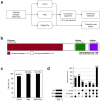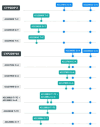The variation landscape of CYP2D6 in a multi-ethnic Asian population
- PMID: 39030343
- PMCID: PMC11271511
- DOI: 10.1038/s41598-024-67691-6
The variation landscape of CYP2D6 in a multi-ethnic Asian population
Abstract
Cytochrome P450 2D6 (CYP2D6) plays a crucial role in metabolizing approximately 20% of medications prescribed clinically. This enzyme is encoded by the CYP2D6 gene, known for its extensive polymorphism with over 170 catalogued haplotypes or star alleles, which can have a profound impact on drug efficacy and safety. Despite its importance, a gap exists in the global genomic databases, which are predominantly representative of European ancestries, thereby limiting comprehensive knowledge of CYP2D6 variation in ethnically diverse populations. In an effort to bridge this knowledge gap, we focused on elucidating the CYP2D6 variation landscape within a multi-ethnic Asian cohort, encompassing individuals of Chinese, Malay, and Indian descent. Our study comprised data analysis of 1850 whole genomes from the SG10K_Health dataset using an in-house consensus algorithm, which integrates the capabilities of Cyrius, Aldy, and StellarPGx. This analysis unveiled distinct population-specific star-allele distribution trends, highlighting the unique genetic makeup of the Singaporean population. Significantly, 46% of our cohort harbored actionable CYP2D6 variants-those with direct implications for drug dosing and treatment strategies. Furthermore, we identified 14 potential novel CYP2D6 star-alleles, of which 7 were observed in multiple individuals, suggesting their broader relevance. Overall, our study contributes novel data on CYP2D6 genetic variations specific to the Southeast Asian context. The findings are instrumental for the advancement of pharmacogenomics and personalized medicine, not only in Southeast Asia but also in other regions with comparable genetic diversity.
© 2024. The Author(s).
Conflict of interest statement
Y.M., M.G.P., L.S. and A.I. are employees of NalaGenetics; R.T.J., N.B. and D.T. declare no competing interests.
Figures




References
-
- PharmVar - CYP2D6. https://www.pharmvar.org/gene/CYP2D6.
-
- Guidelines – CPIC. https://cpicpgx.org/%20guidelines/.
MeSH terms
Substances
LinkOut - more resources
Full Text Sources
Miscellaneous

